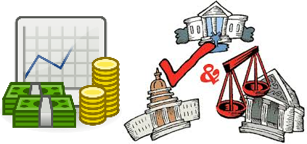Phase 1: Fall 2024 - The Loans and the Living Expenses
A new farmer named John buys a 300-acre farm in Van Wert, Ohio. To do this, he takes out a complex set of loans designed for a farm's unique financial cycle.
The Long-Term Debt:
A 30-year, $3,000,000 mortgage for the land.
A 7-year, $300,000 equipment loan for a tractor and combine.
These require fixed monthly payments totaling $14,660, starting immediately.
The Annual Operating Loan (The Key to Survival):
John gets pre-approved for a $200,000 operating loan for the 2025 season. This is the cash he will use to run his farm and his household for the entire year.
How the money is budgeted: The loan is designed to cover two things:
Farm Expenses: All the costs for seed, fertilizer, fuel, and labor.
Family Living Expenses: This portion of the loan is specifically budgeted to cover the family's groceries, utilities, and, most importantly, the $14,660 monthly mortgage and equipment payments.
In short, John will be using borrowed money to pay the bank its monthly loan payments, with the plan to pay everything back after his first harvest.
Phase 2: Winter 2024-2025 - The Storm Gathers
In January, the new administration's policies create a perfect storm of financial problems that attack John's budget from all sides.
Policy #1: Tariffs & Trade War (The Price Problem): A trade war causes the export market for John's future crop to vanish. This creates a massive supply glut, causing the projected price of his harvest to collapse from a profitable $14/bushel to a disastrous $9/bushel.
Policy #2: Immigration & Border Shutdown (The Cost Problem): A border shutdown creates a severe labor shortage. His projected labor costs double from $15/hour to $30/hour.
Other Factors: The trade friction also raises the price of fertilizer, and a predicted perfect growing season threatens to make the supply glut even worse, pushing prices down even further.
Phase 3: Spring & Summer 2025 - The Squeeze and Default
The crisis hits when John's expenses are at their highest. He takes out the $200,000 operating loan to pay for the massive upfront costs of planting.
The Bank's Response Begins:
March: With his cash from the operating loan already spent on planting, John misses his first $14,660 payment. The bank sends an automated notice.
April: He misses the second payment. A loan officer calls personally, and his credit score is damaged.
June (90 Days Delinquent): The bank sends a formal "Notice of Default" by certified mail. This is a legal warning that the foreclosure process is next.
August (120+ Days Delinquent): The file is handed over to the bank's attorneys, who are now legally cleared to sue John.
Phase 4: October 2025 - The Collapse
John completes his harvest, but the income is a disaster. It's not even enough to pay back the $200,000 operating loan.
Total Default: He is now in default on all his loans.
The Bank's Final Move: The bank's lawyers file a foreclosure lawsuit to take possession of the farm.
The Government's "Solution": In early October, with John and thousands of other farmers facing ruin, the Trump administration proposes a new, multi-billion dollar taxpayer-funded bailout to address the very crisis its policies created. John's only hope to save his farm is now a government check.
The Two Endings: A Difficult Choice
Scenario 1: The Bailout Happens
The government passes the multi-billion dollar aid package. Farmers like John receive direct payments.
For the Farmer (John): John gets a government check, stops the foreclosure, and keeps his farm. However, his massive debt remains, and he has now learned to expect government help, potentially creating a cycle of dependency.
For the Bank: The bank gets paid and avoids a major financial loss. This may encourage them to approve risky loans in the future, assuming the government will rescue them again.
For the Economy: The immediate farm crisis is stopped. However, the national debt increases, and the American taxpayer foots the bill to fix a crisis caused by a specific government policy.
Scenario 2: No Bailout Happens
The government does not pass an aid package, leaving the market to work on its own.
For the Farmer (John): The foreclosure proceeds. The bank takes the farm and all the equipment. John and his family lose their home, their business, and their life savings, and he is left bankrupt.
For the Bank: The bank is forced to sell the farm at a loss. If this happens with many farmers, the local bank could become financially unstable and stop lending to the community.
For the Economy: A wave of farm foreclosures could trigger a rural recession. Property values could crash. The market would eventually correct itself, but only after thousands of families are financially ruined and many rural communities are devastated.



No comments:
Post a Comment